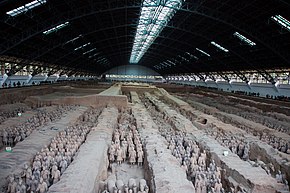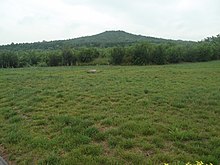Hokbong Terakota
| UNESCO World Heritage Site | |
|---|---|
 | |
| Krayteriya | Cultural: i, iii, iv, vi |
| Toltolan | 441 |
| Inskripsyon | 1987 (11th Sesyon) |
| Websityo | www |
| Tagboan | 34°23′06″N 109°16′23″E / 34.38500°N 109.27306°ETagboan: 34°23′06″N 109°16′23″E / 34.38500°N 109.27306°E |
| Hokbong terakota | |||||||||||||||||||||
| Pinasimpling Intsik | 兵马俑 | ||||||||||||||||||||
|---|---|---|---|---|---|---|---|---|---|---|---|---|---|---|---|---|---|---|---|---|---|
| Tradisyonal na Intsik | 兵馬俑 | ||||||||||||||||||||
| Literal na boot sabihon | Mga pigurin nin lulubngan kan batalan asin kabayo | ||||||||||||||||||||
| |||||||||||||||||||||
An Hokbong Terakota kadamotan nin mga terakotang eskultura nagrerepresentar kan hokbo ni Qin Shi Huang, an pinakaenot na emperador nin Tsina. Ini sarong porma nin arteng puneraryo na ilinubong kadungan kan emparador kan 210–209 BCE sa katuyohan na magbantay saiya sa saibong-na-buhay.
An mga pigurin, nag'eedad na mga 200 BCE,[1] nadukayan kan 1974 kan mga tagaduman na mga parauma sa Lintong County, luwas nin Xi'an, Shaanxi, Tsina. An mga pigurin nag'iiba-iba an langkaw depende sa ranggo, na an mga pinakahalangkaw iyo an mga heneral. An mga pigurin kabali an mga manlulusad (warrior), karong pang-gera asin mga kabayo. Pinagtantya kan 2007 na an tolong kalot na naglalaman kan Hokbong Terakota igwang 8,000 mga soldados, 130 karong pang-gera na may 520 na kabayong paraguyod, asin 150 cavalry'ng mga kabayo, na an mga mayoriya kaini namumugtak sa lugar in situ harani sa mausuleo ni Qin Shi Huang.[2] Iba pang mga terakota nakua, mga pigurin na bakong-militar sa mga iba pang mga kalot, arog kan mga opsiyales, sirkero, mga gwardya asin mga musiko.[3] Plantilya:Toclimit
Historya
[baguhon | baguhon an source]

 ). An lolobngan na sentral mismo dai pa nahohonggad.[4]
). An lolobngan na sentral mismo dai pa nahohonggad.[4]An konstruksyon kan lulubngan susog sa pagladawan kan historyador na si Sima Qian (145–90 BCE) kan Mga Rekord kan Dakulang Historyador, an pinakaenot sa 24 dynastiyang historya in TsinA, sinurat sarong siglo pakatapos pakahaman kan mausuleo. An pagtrabaho sa mausuleo nagpoon kan 246 BCE, pakatukaw lamang ni Emperador Qin (edad pa sana 13) sa pagsalida sa ama niya bilang Hade nin Qin, asin an proyekto naimbwelto an 700,000 na mga trabahador.[5][6] An Geograpong si Li Daoyuan, na nagsusurat pakalihis nin anom na siglo kan pagkagadan kan enot na emperador, iginuhit na Shui Jing Zhu an Mount Li paboritoong lokasyon ta huli kan mayaman na geologo kaini, mayaman sa mga mineral: "bantogan sa minang jade, an bandang amnayan mayaman sa bulawan, asin an bandang habagatan kaini mayaman man sa magagayon na jade; an enot na emperador, ara' na gayo kan reputasyon kaini, kaya pinili na duman siya ilubong".[7][8]
Si Sima Qian nagsurat na si enot na emperador ilinubong sa lugar na may mga palasyo, mga torre, opisyales,mga mahahalangang mga artifaks asin mga nakakawiling mga bagay. Susog sa saysay na ini, 100 na nagdadalahay na salog sagin piggibo gamit an asupre, asin an kisame pigsamnohan nin mga bulan asin bitoon na naghitsurang langit, asin ibaba kaini an topograpiya kan kadagaan. An ibang mga pagpalis kan saysay na ini nasasambitan an mga "modelo"; alagad, an sa orihinal na teksto dai man ginamit an mga tataramon na na iyan, asin dai man ngani nabanggit an hokbong terakot.[5][9] High levels of mercury were found in the soil of the tomb mound, giving credence to Sima Qian's account.[10] Also, the Emperor is well documented for building monumental statues in human form during his reign, such as the Twelve Metal Colossi.[11][12]
Ngapit an mga saysay na historikal garo nagseswestyon na an lugar na linubngan pigparakotkot asin hinabonan ni Xiang Yu, saro sa kagtukaw sa trono pakagadan kan e4not na emperador.[13][14][15] Alagad, may mga indikasyon man na an lulubngan mismo pwedeng dai man pigha'bonan.[16]
Toltolan
[baguhon | baguhon an source]- ↑ Lu Yanchou; Zhang Jingzhao; Xie Jun; Wang Xueli (1988). "TL dating of pottery sherds and baked soil from the Xian Terracotta Army Site, Shaanxi Province, China". International Journal of Radiation Applications and Instrumentation, Part D 14 (1–2): 283–286. doi:.
- ↑ Portal 2007, p. 167.
- ↑ Error sa pag-cite: Imbalidong
<ref>tatak; mayong teksto na ipinagtao para sa reperensiya na pinagngaranan na:0 - ↑ WILLIAMS, A. R. (12 October 2016). "Discoveries May Rewrite History of China's Terra-Cotta Warriors" (in en). National Geographic. https://www.nationalgeographic.com/history/article/china-first-emperor-terra-cotta-warriors-tomb.
- ↑ 5.0 5.1 Sima Qian – Shiji Volume 6 Archived 5 October 2013 at the Wayback Machine. 《史記•秦始皇本紀》 Original text: 始皇初即位,穿治酈山,及並天下,天下徒送詣七十餘萬人,穿三泉,下銅而致槨,宮觀百官奇器珍怪徙臧滿之。令匠作機駑矢,有所穿近者輒射之。以水銀為百川江河大海,機相灌輸,上具天文,下具地理。以人魚膏為燭,度不滅者久之。二世曰:"先帝後宮非有子者,出焉不宜。" 皆令從死,死者甚眾。葬既已下,或言工匠為機,臧皆知之,臧重即泄。大事畢,已臧,閉中羨,下外羨門,盡閉工匠臧者,無複出者。樹草木以象山。 Translation: When the First Emperor ascended the throne, the digging and preparation at Mount Li began. After he unified his empire, 700,000 men were sent there from all over his empire. They dug down deep to underground springs, pouring copper to place the outer casing of the coffin. Palaces and viewing towers housing a hundred officials were built and filled with treasures and rare artifacts. Workmen were instructed to make automatic crossbows primed to shoot at intruders. Mercury was used to simulate the hundred rivers, the Yangtze and Yellow River, and the great sea, and set to flow mechanically. Above, the heaven is depicted, below, the geographical features of the land. Candles were made of "mermaid"'s fat which is calculated to burn and not extinguish for a long time. The Second Emperor said: "It is inappropriate for the wives of the late emperor who have no sons to be free", ordered that they should accompany the dead, and a great many died. After the burial, it was suggested that it would be a serious breach if the craftsmen who constructed the tomb and knew of its treasure were to divulge those secrets. Therefore, after the funeral ceremonies had completed, the inner passages and doorways were blocked, and the exit sealed, immediately trapping the workers and craftsmen inside. None could escape. Trees and vegetation were then planted on the tomb mound such that it resembled a hill.
- ↑ "Chinese terra cotta warriors had real, and very carefully made weapons". The Washington Post. 26 November 2012. https://www.washingtonpost.com/national/health-science/chinese-terra-cotta-warriors-had-real-and-very-carefully-made-weapons/2012/11/26/999b9cb4-2840-11e2-b4e0-346287b7e56c_story.html.
- ↑ Clements 2007, p. 158.
- ↑ Shui Jing Zhu Chapter 19 Archived 17 October 2012 at the Wayback Machine. 《水經注•渭水》Original text: 秦始皇大興厚葬,營建塚壙於驪戎之山,一名藍田,其陰多金,其陽多美玉,始皇貪其美名,因而葬焉。
- ↑ Portal 2007, p. 17.
- ↑ Portal 2007, p. 202.
- ↑ Qingbo, Duan, Director of the excavation team at the First Emperor's necropolis from 1998 to 2006 (2022). "Sino-Western Cultural Exchange as Seen through the Archaeology of the First Emperor's Necropolis" (in en). Journal of Chinese History 中國歷史學刊 7: 67–70. doi:. ISSN 2059-1632.
- ↑ Nickel, Lukas (October 2013). "The First Emperor and sculpture in China" (in en). Bulletin of the School of Oriental and African Studies 76 (3): 436–450. doi:. ISSN 0041-977X. https://doi.org/10.1017/S0041977X13000487.
- ↑ Shui Jing Zhu Chapter 19 Archived 17 October 2012 at the Wayback Machine. 《水經注•渭水》 Original text: 項羽入關,發之,以三十萬人,三十日運物不能窮。關東盜賊,銷槨取銅。牧人尋羊,燒之,火延九十日,不能滅。Translation: Xiang Yu entered the gate, sent forth 300,000 men, but they could not finish carrying away his loot in 30 days. Thieves from northeast melted the coffin and took its copper. A shepherd looking for his lost sheep burned the place, the fire lasted 90 days and could not be extinguished.
- ↑ Sima Qian – Shiji Volume 8 Archived 6 May 2015 at the Wayback Machine. 《史記•高祖本紀》 Original text: 項羽燒秦宮室,掘始皇帝塚,私收其財物 Translation: Xiang Yu burned the Qin palaces, dug up the First Emperor's tomb, and expropriated his possessions.
- ↑ Han Shu Archived 8 December 2015 at the Wayback Machine.《漢書·楚元王傳》:Original text: "項籍焚其宮室營宇,往者咸見發掘,其後牧兒亡羊,羊入其鑿,牧者持火照球羊,失火燒其藏槨。" Translation: Xiang burned the palaces and buildings. Later observers witnessed the excavated site. Afterward, a shepherd lost his sheep which went into the dug tunnel; the shepherd held a torch to look for his sheep, and accidentally set fire to the place and burned the coffin.
- ↑ "Royal Chinese treasure discovered". BBC News. 20 October 2005. http://news.bbc.co.uk/1/hi/world/asia-pacific/4359774.stm.
[[Kategorya: Categories: Archaeology of ChinaInfantry units and formationsMilitary and war museums in ChinaArchaeological museums in ChinaQin dynastyWorld Heritage Sites in ChinaTourist attractions in Xi'anTerracotta sculptures1974 archaeological discoveriesMuseums in Xi'anAAAAA-rated tourist attractionsMilitary artFunerary artQin Shi Huang1974 in ChinaNational first-grade museums of China

